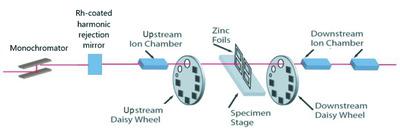当前位置:
X-MOL 学术
›
J. Synchrotron Radiat.
›
论文详情
Our official English website, www.x-mol.net, welcomes your
feedback! (Note: you will need to create a separate account there.)
High-accuracy mass attenuation coefficients and X-ray absorption spectroscopy of zinc – the first X-ray Extended Range Technique-like experiment in Australia
Journal of Synchrotron Radiation ( IF 2.4 ) Pub Date : 2021-07-19 , DOI: 10.1107/s1600577521005993 Ruwini S K Ekanayake 1 , Christopher T Chantler 1 , Daniel Sier 1 , Martin J Schalken 1 , Alexis J Illig 1 , Martin D de Jonge 2 , Bernt Johannessen 2 , Peter Kappen 2 , Chanh Q Tran 3
Journal of Synchrotron Radiation ( IF 2.4 ) Pub Date : 2021-07-19 , DOI: 10.1107/s1600577521005993 Ruwini S K Ekanayake 1 , Christopher T Chantler 1 , Daniel Sier 1 , Martin J Schalken 1 , Alexis J Illig 1 , Martin D de Jonge 2 , Bernt Johannessen 2 , Peter Kappen 2 , Chanh Q Tran 3
Affiliation

|
The first X-ray Extended Range Technique (XERT)-like experiment at the Australian Synchrotron, Australia, is presented. In this experiment X-ray mass attenuation coefficients are measured across an energy range including the zinc K-absorption edge and X-ray absorption fine structure (XAFS). These high-accuracy measurements are recorded at 496 energies from 8.51 keV to 11.59 keV. The XERT protocol dictates that systematic errors due to dark current nonlinearities, correction for blank measurements, full-foil mapping to characterize the absolute value of attenuation, scattering, harmonics and roughness are measured over an extended range of experimental parameter space. This results in data for better analysis, culminating in measurement of mass attenuation coefficients across the zinc K-edge to 0.023–0.036% accuracy. Dark current corrections are energy- and structure-dependent and the magnitude of correction reached 57% for thicker samples but was still large and significant for thin samples. Blank measurements scaled thin foil attenuation coefficients by 60–500%; and up to 90% even for thicker foils. Full-foil mapping and characterization corrected discrepancies between foils of up to 20%, rendering the possibility of absolute measurements of attenuation. Fluorescence scattering was also a major correction. Harmonics, roughness and bandwidth were explored. The energy was calibrated using standard reference foils. These results represent the most extensive and accurate measurements of zinc which enable investigations of discrepancies between current theory and experiments. This work was almost fully automated from this first experiment at the Australian Synchrotron, greatly increasing the possibility for large-scale studies using XERT.
中文翻译:

锌的高精度质量衰减系数和 X 射线吸收光谱——澳大利亚第一个类似 X 射线增程技术的实验
介绍了在澳大利亚澳大利亚同步加速器进行的第一个类似 X 射线增程技术 (XERT) 的实验。在该实验中,X 射线质量衰减系数在包括锌K吸收边缘和 X 射线吸收精细结构 (XAFS)的能量范围内测量。这些高精度测量值在 8.51 keV 到 11.59 keV 的 496 个能量下记录。XERT 协议规定,由于暗电流非线性、空白测量校正、全箔映射来表征衰减、散射、谐波和粗糙度的绝对值导致的系统误差在实验参数空间的扩展范围内进行测量。这会产生用于更好分析的数据,最终测量整个锌K的质量衰减系数-edge 精度为 0.023–0.036%。暗电流校正与能量和结构有关,较厚样品的校正幅度达到 57%,但对于薄样品仍然很大且很显着。空白测量将薄箔衰减系数按比例缩放 60–500%;即使对于较厚的箔,也可高达 90%。全箔映射和表征校正了高达 20% 的箔之间的差异,从而提供了绝对测量衰减的可能性。荧光散射也是一个主要的修正。研究了谐波、粗糙度和带宽。使用标准参考箔校准能量。这些结果代表了对锌的最广泛和最准确的测量,可以调查当前理论和实验之间的差异。
更新日期:2021-09-03
中文翻译:

锌的高精度质量衰减系数和 X 射线吸收光谱——澳大利亚第一个类似 X 射线增程技术的实验
介绍了在澳大利亚澳大利亚同步加速器进行的第一个类似 X 射线增程技术 (XERT) 的实验。在该实验中,X 射线质量衰减系数在包括锌K吸收边缘和 X 射线吸收精细结构 (XAFS)的能量范围内测量。这些高精度测量值在 8.51 keV 到 11.59 keV 的 496 个能量下记录。XERT 协议规定,由于暗电流非线性、空白测量校正、全箔映射来表征衰减、散射、谐波和粗糙度的绝对值导致的系统误差在实验参数空间的扩展范围内进行测量。这会产生用于更好分析的数据,最终测量整个锌K的质量衰减系数-edge 精度为 0.023–0.036%。暗电流校正与能量和结构有关,较厚样品的校正幅度达到 57%,但对于薄样品仍然很大且很显着。空白测量将薄箔衰减系数按比例缩放 60–500%;即使对于较厚的箔,也可高达 90%。全箔映射和表征校正了高达 20% 的箔之间的差异,从而提供了绝对测量衰减的可能性。荧光散射也是一个主要的修正。研究了谐波、粗糙度和带宽。使用标准参考箔校准能量。这些结果代表了对锌的最广泛和最准确的测量,可以调查当前理论和实验之间的差异。











































 京公网安备 11010802027423号
京公网安备 11010802027423号